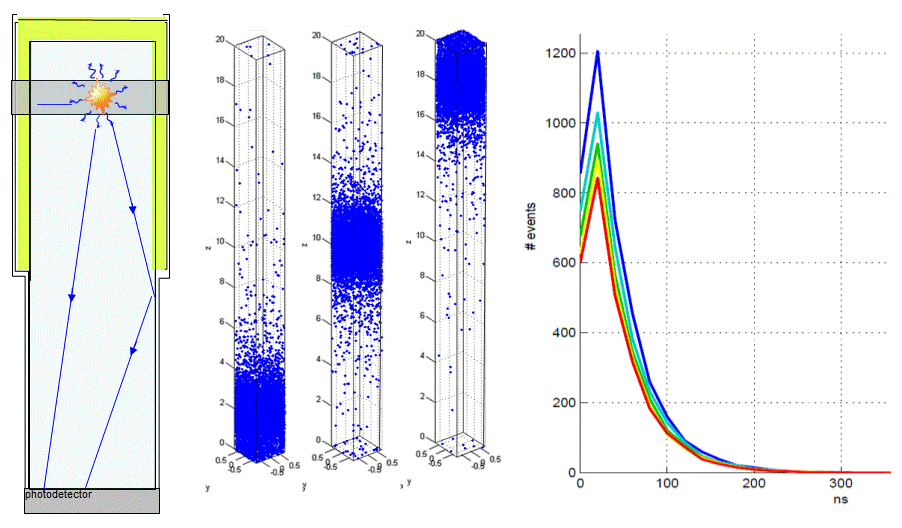In recent years depth of interaction (DOI) PET detector design has been a very active area of development. Various depth-encoding detector designs have been proposed. Pulse shape discrimination (PSD) methods have been used with combination of crystals with different decay times and provided a DOI resolution of 5-8 mm, but the DOI information is discrete and limited by the thickness of the different crystal layers. Continuous information of DOI with a resolution of 2-3 mm can be achieved with dual-ended read-out of the scintillator, but this solution requires more electronics.
We have proposed an alternative solution combining the advantages of a single readout detector and continuous DOI information [1]. A yttrium-aluminium-gallium oxide (YGG) phosphor coating is applied on some fraction of the external surface of a lutetium oxyorthosilicate (LSO) crystal. A photodetector coupled to that scintillator detects a mixture of the scintillation light coming from LSO and the light converted by the phosphor. This second contribution is delayed and the resulting light pulse has a longer decay time. This decay time is related to the ratio of light converted by the phosphor, which is depth dependent. A DOI resolution of 8 mm has been obtained with an array of 1.5 mm x 1.5 mm x 20 mm LSO crystals and YGG coupled to a photomultiplier tube (PMT). Improvements may be made by employing photodetectors with higher photodetection efficiency in the phosphor emission range (the peak is at 550 nm), such as silicon photomultipliers.
To improve upon these results, several concepts are being explored. First, the use of silicon photomultipliers is expected to enhance the depth of interaction resolution, since the photodetection efficiency they exhibit at the phosphor emission wavelengths is higher than the quantum efficiency of photomultiplier tubes. Initial experiments conducted with Multi Pixel Photon Counter devices (MPPC, Hamamatsu Photonics) produced promising results in decay time measurements. Additional testing will be performed on devices from other manufacturers. Secondly, a simulation tool was developed to model crystals coated with phosphor or other materials. This simulation tool allows to model various materials, shapes and produces light pulses with their associated spectra. The goal of simulation studies is twofold: we want to vary the parameters of the coating in order to obtain the best depth of interaction resolution and also to investigate pulse shape discrimination methods.

Fig. 2: Left: model of a crystal coated with a phosphor layer and example of light paths.Middle: generation of 104 photons at different depths in the crystal.Right: simulated output pulses for 104 photons generated at each depth
The actual discrimination of the pulses is based on the decay time of the pulses only. Future work includes the development of methods incorporating more information such as the variation of the rise time or spectral information.
Refernces:
1. H. Du et al., “Continuous depth-of-interaction encoding using phosphor-coated scintillators,” Physics in medicine and biology, vol. 54, pp. 1757-1771, 2009.

